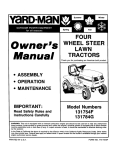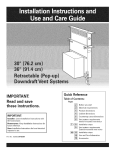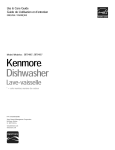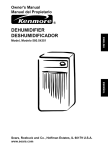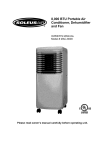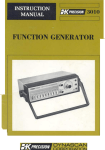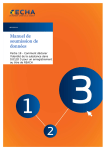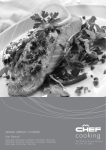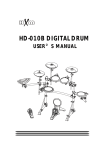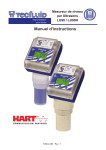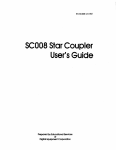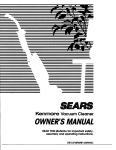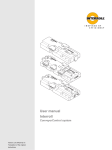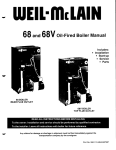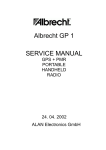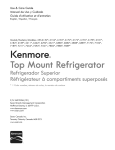Download Pitco Frialator SF14 UFM User's Manual
Transcript
v J J MI'S , PF28-03 Pita> Frialator '1..20-086-01 Rev00 Rev.Due 12117/93 ~ NonCES There are three different types of noti~s that you should be familiar with, a NO11CE, CAunON, and WARNING. A NO11CE is a specialnote usedto call attention to a particularly important point CAunON is used to point out a procedureor operation which may causeequipmentdamage. The WARNING notice is the most important of the three becauseit warns of an operationthat may cause personalinjury. Pleasefamiliarize yourself with your new rooter before operating it and heed the notices throughout this manual. The WARNINGS are listed below and on the following page for your review prior to operating the unit ~ SAFETY SAFETY SAFETY SAFETY SAFETY The fryer is equipped with an oil proof, electrical supply oord with a three prong safety plug. This is to protect operatorsfrom electrical shock hazard in the event of an equipment malfunction. DO NOT cut or remove the grounding (dlird) prong from this plug. ~==I There is an open flame inside the fryer. The unit may get hot enough to set nearby materials on file. Keep the areaaround the fryer free from combus- tibles. ~==I DO NOT supply the fryer with a gasthat is DOtindicated on the data plate. If you needto convert the fryer to another type of fuel, oontactyour dealer. DO NOT useanopenflame to checkfor gasleaks! Wait S minutes before attempting to relight the pilot to allow for any gas in the fryer to dissipate. 1~:i~:~:~::::;;11I Nevermelt blocksof shorteningon top of a fire, andvoid your warranty. Water and shortening DO NOT mix. Keep liquids away from hot shortening. Dropping liquid frozen food into the hot shorteningwill causeviolent boiling. At operatingtemperaturethe shorteningtemperaturemay be greaterthan 3OOoP.Extremecareshouldbe usedwhenfiltering operatingtemperature shorteningto avoid personnelinjury. ;AFETY SAFETY SAFETY SAFETY SAFETY SAFETY S~FETY S:AFETY SAFETY S:AFETY It will be easierandsaferif thefilter assemblyhasoooledto room temperature before handling any filter parts. Ensure that the fryer can get enough air to keep the flame burning oorrectly. If the flame is starvedfor air it can give off a dangerouscarbonmonoxide gas. CarbonMonoxideis a clearodorlessgasthat cancausesuffocation. [:~:::;:::~:::;;;;III A cooker equippedwith castersand a flexible power cord, must be connected to the gas supply with a Quick-Disconnect devi~. This quick disconnect must comply with ANSI Z24.41. To limit the movement of the cooker without dependingon the connectoror quick disconnect, a restraining cable must also be installed. The power supplymust be applian~. SAFETY SAFETY SAFETY SAFETY SAFETY Tableof Contents Title Section Safety - Notice Tableof Contents Ust of TablesandFigures 1.1 1.2 1.2.1 1.3 1.3.1 1.3.2 1.4 1.4.1 1.4.2 1.4.2.1 1.4.2.2 1.4.2.3 1.4.2.4 1.4.3 1.4.4 1.5 1.5.1 1.5.2 1.5.2.1 1.5.2.1.1 1.5.3 1.5.3.1 1.5.3.2 1.5.4 1.5.5 1.5.6 1.5.7 i-ii ill WInCH FRYERDO I HAVE? CHECKINGYOUR NEW FRYER Cleck Your Order ASSEMBLY AND LEVEUNG HeatDeflectorIn..ct31lation Leveling INSTAUA 110N InstallationClearan~ GasConnection FuelTypes GasLine Connection Quick DisconnectGasConnection Fuel SupplyLine Leak andPressureTesting ElectricalConnection... VentilationandFire SafetySystems INl11AL ADJUSTMENTS Visual Checks BurnerIgnition Systems lighting Instructionsfor ManualPilot Lights Pilot FlameAdjustment Main BurnerSystem GasLine Requirements BurnerAdjustment Initial Cleaning ThennostatCalibrationCheck ThennostatCalibration High Limit Test ... ... ~ ... 1-1 1-2 1-2 1-2 1-2 1-3 1-3 1-4 1-4 1-4 1-5 1-5 1-5 1-5 1-6 1-7 1-7 1-8 1-8 1-9 1-11 1-12 1-12 1-13 1-14 2: 2.1 2.1.1 2.1.2 2.2 f1LLING nIB FRYER Filling theFryer With Liquid Shortening Filling theFryer With Solid Shortening MELTING SOLID SHORTENING i 2-1 2-1 2-1 2-2 Tableof Contents(Continued) Section ntle Page 2.3 2.3.1 2.3.2 2.3.3 2.4 2.4.1 2.4.2 2.S OPERA11NGINSTRUcnONS Fryer Start-Up Fryer Shutdown PowerFailure ... ... " ..,.. SHORTENINGFILTER PROCEDURES .,.,." GeneralFilter Hints Filter Procedures. DAn.,Y CLEANING 3.1 3.2 3.3 3.4 3.4.1 3.4.2 Fll..TER MEDIA REPLACEMENT WEEKLY FRYER CLEANING (BOIL OUT) f1..UEINSPEC'fION TROUBLESHOOTING Fryer Troubleshooting Filter Troubleshooting... ii ,..",.,...,..." ... 2-2 2-2 2-3 2-3 2-4 2-5 2-6 2-7 ,.., ... ... 3-1 3-4 3-4 3-5 3-5 3-6 List of Tablesand Figures 1-1 Fryer Model Information 1-2 Ventilation andFire SafetyReferences Title Figure 1-1 1-2 1-3 1-4 1-5 InsideView of Fryer Pilot Assembly,FlameAdjustment GasVaJveShowingLocationof PressureRegulatorand Pilot Adjusters Main BurnerConditions Air Collar 2-1 Fryer mustratingFilter Components 3-1 Filter Module iii 1-1 1-6 Page 1-9 1-9 1-10 1-11 1-12 iv Chapter 1: GeneralInformation and Installation The frying systemyou have selectedfor your establishmentis the Pita> Frialator Model SF14 UFM series.This model oombinesthe oonvenienceof built-in filtration andthe compactnessof underfryer filtration into one easyto useunit. This fryer will give you many yearsof reliable service if you follow the simple operation and maintenanceproceduresin this manual. Containedin this manual are the general installation, operation, and maintenanceproceduresfor the SF14UFM and SFI4RUFM. 1.1 WHICH FRYER DO I HAVE? There aretwo modelsavailablewith solo filters andboth canusethe sameoptions. To find out which model you have, look inside the door at the equipment identification plate. This plate has a lot of useful information, but to identify which fryer you have,look at themodel numberblock. The model number identifies which fryer and what featuresyou have. A brief description of each model and it's features is provided in table 1-1. Table 1-1 FryerModel Information 1-1 1.2 CHECKING YOUR NEW FRYER Your new fryer and it's filter havebeen carefully packedinto one crate. Every effort basbeenmade to ensurethat your fryer will be delivered to you in perfectcondition. As you unpackyour new fryer, inspect each of the pieces for damage. If something is damaged,DO NOT sign the bill of lading. Contact the shipper immediately, the shipper is only responsiblefor 15 days after delivery. Check the packing list enclosedwith your fryer to ensurethat you havereceived all of the parts to the fryer. If you are missing any parts, contactthe dealerfrom whom the fryer was purchased.As you unpack the fryer and it's accessoriesbe careful to keep the weight of the fryer evenly distnbuted. CAunON To preventequipmentdamage,don't tilt the fryer onto any two of it's castersor pull the unit by the flue vents. Locate your Pitco Frialator warranty and fill in the serial number of the fryer and the date received. Y 00 will fmd the serial number on the plate inside the door. Put your warranty card in a safe place for future referen~. DO NOT return the card to Pitco Frialator. 1.2.1 Check Your. The cratecontainingthe fryer unit will alsocontainthe itemslisted below Theseitemsarevery importantand MUST be retainedfor future use. A completedescriptionof eachoomponentis containedin the ShorteningFilter Procedurein Chapter2. (2) (2) (1) ~) (1) (1) Fry basketsper fryer PitcoOeanerSample Filter Crumb Catch Filter Paper FryerCrumbScoop HeatDeflector 1.3 ASSEMBLYAND LEVEUNG (1) (1) (1) (1) (1) Fry BasketHangerper fryer Drain OeanOut Rod PrecoatFilter Aid OeaningBrush(Fryer) Filter CrumbSa>op Whenyou receiveyour fryer it is completelyassembled with the possibleex~ptioD of the heat deflector. You will find a removablelabel at the rear top edgeof the unit. This label hasinstructionsfor positioningand installationof the heatdeflector. Referto the label andthe instructionsbelow to installthe deflector. 1-2 a. Removethe two self-drilling saews from the top, back area of the cooker. b. Position the heat deflector so that the angledportion of the deflector is facing toward the front of the fryer. Securethe heat deflector to the back of the unit using the sheetmetal saews previously removed. ~:=I DO NOT obstruct the flow of combustioD/ventilationor air openings around the fryer. Adequatecl~ around the fryer is necessaryfor servicing and proper burner operation. Ensure that you meet the minimum clearances specified in the installation instructions. Co When properly installed the angledsection of the heatdeflector will extend over the flue openingto redirect the heal It SHOUlD NOT rover the flue opening. Nothing should block the flue opening as this will causethe fryer to overheat and produce dangerous gases. 1.3.2. Leveling Using an appropriatewrench and level ensurethat the unit is level. a. Place the level acrossthe front of the tank and rotate the adjustment on the front legs to level the unit. b. Perform stepa to level the unit front to back by placing the level along the side of thetank. 1.4 INsrAL1.ATION Although it is poSSIblefor you to install and set up your new fryer, it is STRONGLY recommended that you have it doneby qualified professionals. The professionalsthat install your new fryer will know the local building codes and ensurethat your installation is safe. ~==I The fryer must be properly restrainedto prevent movement or tipping. This restraintmust prevent thefryer from movementsthatwould splashhot liquids on personnel. This restraint may be any means(alcove installation, adequate ties, or battery installation). 1-3 Non-Combustible Construction 6" 6" N/A Combustible Construction Back Sides 6" 6"N/A In addition to the clearancesrequired for proper fryer operation, there must be at least 23 inches of Your fryer will give you peak performancewhen the gas supply line is of sufficient size to provide thecorrect gasflow. The gas line must be installed to meet the local building codesor National Fuel GasCode (NFPA 54-1984) and ANSI Z223.1-1988 Latest Edition. In Canada,install the fryer in aax>rdancewith CAN/CGA-B149.1 or .2 and local codes. Gas line sizing requirements can be determinedby your local gas company by referring to National Fuel Gas Code,Appendix c, Table C-4 (natural gas) and Table C-16 (propane). The gas line needsto be large enough to supply the necessaryamount of fuel to all applianceswithout losing pressureto any appliance. Other factors that are used to determine the piping requirementsare BTU requirements of the appliances being oonnectedand the length of pipe betweenthe meter (main shut oft) and the appliances. [:::1 NEVER supply the fryer with a gas that is Dot indicated on the data plate. Using the inoorrect gas type will causeimproper operation. If you need to 1.4.2.1 Fuel~s - Each fryer is equippedto work with one type of fuel. The type of fuel with whichtheappliance is intended to operateis stampedon the data plate attadled to the inside of the door. DO NOT useanopen for gasleaks! 1-4 1.4.2.2 Gas Line Connection - Connect the fryer to the gas supply line with a oonnector that amplies with the Standardfor Connectorsfor Movable GasAppliances (ANSI Z21.69-1987). If you are installing a fryer with castersuse a quick disoonnectrefer to the Quick Disconnect installation instruction, 1.4.2.3. Connect the gas line to the fryer using a pipe joint sealantthat is resistantto liquefied petroleum. If the fryer was disoonnectedduring the fuel line testing,usea solution of soap and water to leak test the new oonnection. NonCE NEVER use an adaptorto makea smallergas supply line fit the cooker connedion. This may not allow proper gas flow for optimum burner operation,resultingin poor cookerperforman~.. 1.4.2.3 OuickDjsa)nnectGasConnection-Gasfryers equippedwith castersmust be installed with connedors thatcomply with theStandud for Connectorsfor Movable Gas Appliances, ANSI 221.69-1987, and Addenda Z21.69A-1989. This connection should include a quick disconned device that complies with the Standard for Quick Disamnect Devi~ for Use With GasFuel, ANSI Z21.41-1989. When installing a quick disoonnectyou mustalso install a meansfor limiting the movementof the fryer. This device will prevent the gas line or the quick disronnect from being strained. The restraining device should be attached to the cooker on the back panel as shownin the illustration. The quick disconnect,hose,and restraining device can be obtained from your dealer. - 1.4.2.4 Fuel SYR~IXLine Leak and PressureTestine The fuel supplysystemmust be tested before the fryer is used. If the fuel line is going to be tested at a pressuregreaterthan (»1/2 PSIG (3.45 kPa), make sure that the fryer is disamneded from the fuel line. If the fuel line is to be tested at a pressureequal to or less than (s) 1/2 PSIG (3.45 kPa), the fryer can be COft-!!e-m.rlbut the unit's gasvalve must be shut. Test all gasline connectionsfor leaks with a solution of soapand water when pressureis applied. 1.4.3 Electrical Connection The electrical servi~ usedby the fryer must oomply with local cx>des.If thereareno local a>desthat apply, refer to the National Electrical Code (NEC) to install the servi~. In Canadarefer to CSA StandardC22.1 and local codes. Wiring diagrams are provided inside the fryer door. The power requirementsfor the fryer are shown below. Input Voltage Currentperfryer 120 V Ac, 60Hz 220 (or 240) V Ac, SOliz 7 Amps 3.s Amps 1-5 ~=:I The fryer is equippedwith an oil proof, threeprong (grounding) plug for your protection againstelectrical shock hazardin theeventof equipmentmalfunction. DO NOT cut or removethe grounding (third) prong from this plug. This plug must be plugged into a properly groundedthree prong receptacle. The fryer has one power supply for the fryer controls and the filter module. The fryer must be groundedin accordancewith local code; if there is not a local code,comply with NBC ANSI/NFP A No. 70-1990. The fryer should be plugged into a receptacleat all times to keep power supplied to the filter line heat tape. 1.4.4 VentilatioD and Fire Safety Systems Your new fryer must have proper ventilation to function safely and properly. Exhaust gas temperaturescan reach as high as 1200°F. Therefore, it is very important to install a fire safety system. Your ventilation systemshould be designedto allow for easycleaning. Frequentcleaning of the ventilation system and the fryer will reduce the chan~ of fire. Table 1-2 provides a list of referen~ documentsthat provide guidanceon ventilation and fire safety systems. This table is not necessarilycomplete. Additional information can be obtainedfrom the American GasAssociation, 8501 East PleasantValley Road, Ceveland, OH 44131. Table 1-2. Ventilation and Fire Safety Referen~s 1-6 Excessive ventilation causesdrafts, which will interfere with the proper operation of the pilot and theburner. Leaveat least18inchesof openspacebetweenthe fryer's flue vent opening andthe intake of the exhaust hood. CAU'I10N Ensurethat your ventilation systemdoesnot causea down draft at the fryer's flue opening. Down draftswill not allow the fryer to exhaustproperly and will causeoverheatingwhich may causepermanentdamage. Damagecausedby down drafts will not be covered under equipment warranty. NEVER allow anything to obstrud the flow of combustibles or ventilation exiting from the fryer flue. DO NOT put anything on top of the flue area. NonCE NEVER connectthe blower directly to the flue openings. The direct flow of air will causepoor temperaturerecovery, poor ignition, inefficient operation of the fryer, and could extinguish the pilot. 1.5 INI11AL ADJUSTMENTS After your fryer hasbeeninstalled as describedin section 1.4, it needsto be adjusted to ensurethat it will perform as designed. These adjustmentsmust be performed by a qualified person. To perform theseadjustmentthe following tools will be needed: .. Manometer (low pressuregauge) DC Millivolt Meter . Digital Thermometer (Temperatureprobe) 1.5.1 Visual Checks Before you begin filling and adjusting the fryer, perform the following visual checks: a. After thefryer is in its permanentlocation, check for levelness.Any additional leveling that is necessarycan be perfonned as described in section 1.3. b. Oleck thetemperaturebulbs (thennostat/high-limit), locatedin the fryer tank to ensurethat the mounting screws are tight The figure showstheprobe typical location. Look down inside the fryer tanks to seethe probes. 1-7 Ensure tIIIt Un. 8,. Nt 1_. pen- CAtmON Before going any further, fill the fryer with WATER. Water is usedfor the installation adjustments becausethe temperaturewill never exceed 212°F (100°C) therebyallowing plenty of adjustmenttime. Never let thewater level go below the OIL LEVEL mark on the rear of the tank. G;:a There is an open Bameinside the fryer. The unit may get hot enoughto set near by materials on fire. Keep the area around the fryer free from 1.5.2.1 Li~htin& Instroctions for Manual Pilot l1ihts -To light the pilot light refer to these instructionsandFigure 1-1. Thenumbersin parenthesis referto Figure 1-1callouts. G:::I Wait 5 minutes before attempting to relight the pilot to allow for any gas in thefryer to dissipate. a. Openthe gassupplyvalvesto the fryer. b. Openthe fryer's door to gain accessto the controls. Turn the thermostatcontrol knob (1) counterclockwise to the off position. c. Turn the Unitrol gasvalve knob (tan knob) (2) to the Pll..OT position and push in on the knob. Hold the knob in for approximately one minute to purge the air out of the line. Hold a flame to the pilot light until the pilot (3) ignites. This may tate a little while the first time you light the fryer becauseof air in the lines. Once lit, hold the knob in for approximately 60 secondsand then release. (lJ 0 ~ ~ ~ d. If die pilot goes out wait 5 minutes and repeatstep c. If after three tries the pilot will not remain lit, refer to the operator troubleshooting section of this manual. e. Turn theUnitrol gasvalveknob(tan knob)counterclockwiseto theON position. f. Setthe thermostatcontrolknob to the desiredtemperaturesetting. 1.8 ~~ g. The main burner (4) will light and be controlled by the thermostat. The pilot burner will remain lit regardlessof the switch position. 1.5.2.1.1 Pilot Flame Adiustment - The pilot flame should be adjusted to prod~ the ~r millivolt output from the pilot sensingdevi~. Millivolt output for the thermopile shouldbe between 300 and 500 millivolts. Figure 1-2 shows the pilot assemblywith examples of the incorrect and correct pilot size. Example A illustrates a pilot flame size that is too small to produ~ sufficient millivolt output. Example B is the correct size for proper millivolt output TME~ll£ PILOT IUDU \ \ \ M B A Figure1-2 Pilot Assembly, 1-9 a. This test requires a DC millivolt meter set to a scale of O-l(XK)mv. b. Locatethe thermopile wires coming from the thermostat!HighLimit box going to the gas shut off valve. The wire insulation size decreasesnear the gas valve connections. Co Connectthe negative(-)testprobeto pilot bracket. d. Connectthe positive (+) testprobeto oneof the High Limit terminal e. Removethe pilot flame adjustmentcover. PRESSURE REGULATORLOCATION (UNDER CAP SCREW) PILOT ADJUSTER LOCATION (UNDER CAP SCREW) g. Rotatethescrew in the directionto achievea readingof 400rlO mv for thermopiles. NonCE h. Replacethepilot flame adjustingscrewcover. 1-10 For the burners to work the gas supply valve must be open and the main power switch must be on. The main burner receivesgasfrom the main gassupply through thethermostatically oontrolled valve. When the therDlostatis turned up the gas control valve opens and the pilot will ignite the burners. After the burner system is operating, perfOrDlthe burner adjustmentsin the following procedure. Figure 1-5 illustrates the different oonditions possible for the main burner. -liftofr The Theflame flameseems to wli: thefaa; of theburner. To correct adjust main described in burner as describc 1.5.3.2. EX~IVE incoming gas pressure. Adjust manifold pressureas described in 1.53.2. INsumCIENT GAS PRESSURE Figure 1-4 Main BurnerConditions 1-11 FLOW 1.5.3.1 Gas Une Rgrements - A properly installed gas supply system will deliver 7.0 %2.0. W.Co natural gas(12.0 %2.0.W.c.LP) to all appliancesoonnectedto the line, operatingat full demand. Adjustthe 1.5.3.2 Burner Adjustment -The burnersmust be burner flame using the following procedure. a. Ensurethat the gas oontrol valve is in the OFF position. Remove the manifold pressure tap plug and connect an accuratepressuregauge(rangeof 0-16" w.c. in 0.1" increments) or manometer. b. light the pilot burner (~ 1.5.2)for theunit being testedandadjustthe thermostatto light the main burners. c. The installed presswegaugereadingshouldbe tbesame,~.1., asthat markedODthedata plate inside the door. If the pressureis correct go to step e, if DOt,adjust the pressure. d. To adjust the pressure,removetberegu1atoradjustmentsaewcover(~ Figure 1-3). Use a flat tip screwdriver to adjust the screw until the properpressureis reached. Turning the ~w clockwise will inaease the pressure,counterclockwisewill deaeasethe pressure. f. To removethe pressuregauge,turn gascontrolvalveto OFF. Removethegaugeand install the pressuretapplug. BURNER ORIFICE I"""""'~~ SET SCREW BURNER FI1TING GAS PRESSURE 1 TEST PLUG Figure1-5 Air Collar 1-12 g. Now that the pressureis set for properoperation, set the main burner flame. Unlock the air collars by loosening the set screwfor the collars. Turn the gas control valve to ON and turn thermostatto light the main burners. h. Adjusttheshapeandsizeby raising with well definedinnercones. provided. 1.5.4 INITIAL CLEANING When the fryer is shipped,many of its parts arecoveredwith a thin coat of oil for protection. Before the fryer is ready for cooking it must be cleaned. This will remove the oil coating and any foreign matter that may have !.~JII!ulated during storageand shipment. Perform the cleaning as described below. a. Fill the tank with water and add one packet of Pita> fryer cleaner or a mild detergent. b. Turn the fryer on and set the thermostatto 200~. Allow the fryer to heat for 15 minutes. NonCE Do not leave the fryer unattendedduring cleaning. Never let the water level go below the "OIL LEVEL" mark on the back of the tank. c. Using the fryer cleaning brush, scrubtheinside of the fryer to remove protective coating. d. When cleaningis complete, turn off thefryer main burnersand turn gasvalve knob to the PILOT position. If the fryer haselectronic ignition turn the gas control valve to the OFF position. Drain the water into a containersuitable for hot water and dispose of it. e. When the tank hasoooled, rinse it thoroughly with 0001water. Continue to rinse the tank until the cleanerhas been rinsed, thoroughly from the tank. , f. Using a cleandry cloth, wipe out all of the water. Be very thorough removing the water, becauseany residual water will causehot oil to splatter out of the fryer. CAImaN Mild steel tanks must be wiped down/coatedwith oil to keep the tank from rusting. g. Now that the tank is clean, you are ready to fill and operate the fryer. Refer to 2.1 for instructions on adding shortening to the fryer. 1-13 loSoS Thermostat Calibration Check NOnCE Thermostat calibration requires that the temperature of the fryer be raised aboveboiling. Therefore, you will needto drain the water from the fryer and fill it with oil. Before removing the water, perform the initial cleaning of the fryer. Oeaning the fryer now will preventyou from having to drain the oil and refill with water later. Filling thefryer with oil is describedin 2.1. To perform the calibration checkdetailedbelow you will needa digital thermometer. b. Set the thermostat at 325°F and wait for the temperaturereading on the thermometerto rise. As the temperature rises toward 325°F watch the thermometer closely. c. If the shortening temperaturereaches350oPand the burners DO NOT turn off, turn the thermostatdown. Keep lowering the thermostatsetting until the burners go out. CAtmON (X)uld be defective. Contactyour ASAP representative. d. Let the fryer cycle 4 to 6 times before checking the temperature. Compare the thermometertemperatureagainstthe thermostatsetting. If the values are more than 5°F apart,calibratethe thermostatusing the appropriatecalibration procedurein this manual. 1.5.6 1bennostat Calibration To calibratethe thermostatthe dial must be removedfrom the shaft. The adjustmentfor the thermostatis insidethe dial shaft. a. Placethe sensors. b. SettheThermostatto 325Ofandwait for thetemperaturereadingon thethermometerto rise. c. Let the fryer cycle 4 to 6 timesto ensurethatthe temperaturehasstabilized. Compare 5°F apart,calibratethe thermostatusingthe 1-14 If thevaluesaremorethan procedure. d. Setthe thermostatdial to 32S°F. e. Remove the thermometerdial by pulling the knob straight out. DO NOT rotate the dial. f. Hold the outsideof the shaft soit doesnot move. Use the tip of a small, flat tip screwdriver to scrapeaway the sealing compoundfrom the adjustment screw. g. Turn the adjustmentscrew clockwise to lower the temperaturesetting and counterclockwise to raise the temperature. One quarter turn changesthe temperatureapproximately 25°F. h. Turn the adjustmentuntil the burnersturn on at 32S°F. Repla~ the knob and allow the fryer to cycle 4 to 6 times. Check the temperature of the thermometer against the thermostat dial, if it is greater than 5°F differen~ repeat the calibration procedure. i. Whenthecalibrationis correct,removethethermometerandrep1aC% the tubesaeen. 1.5.7 HIgh Umit Test TIllS TEST SHOULD BE PERFORMED BYOUAUFIED PER.~ONNELONLY 1-1' 1-16 Chapter 2: This chapterdescribeshow to operateyour fryer to obtainthebestperformance.Includedin this chapterarefilling, operating,andcleaninginstructionsfor gasfryers. 2.1 FIUJNG THE FRYER Both liquid and solid shortening can be used in the fryer. If solid shortening is used, it is recommendedthat you usethemelt cycle feature(optional) to melt the shortening. You canmelt solid shortening without the melt option, but you must carefully follow the instruction in section 2.2.2. 2.1.1 FUlingthe Fryer With liquid Shortening a. Makesurethe drainvalveis completelyclosed. b. Fill the fryer with oil to the "Oil Level" line markedon theback of the tank. 2.1.2 FllllDg the Fryer With SoUdShortening .. -. ~==I Nevermelt blocksof solid shorteningon top of the burner tubes. This will causea fire, andwill void your warranty. Pa. a. Make sure the drain valve is completely closed. b. Remove the screenoovering the tubes. c. Cut the shortening into cubes DOlarger than I". ALWAYS pack the shorteningbelow, between, and on top of the burner tubes. DO NOT leave any large air gaps. Use care when packing the solid shortening in the tank. DO NOT bend or break the temperaturesensorprobes. If thesearedamagedthe fryer will not function properly. ~ d. Once the fryer is packedwith shortening, the shorteningmust be melted. To melt the shortening refer to the Fryer Start-Up section for your fryer 2-1 2.2 MEL11NGSOLID SHORTENING NonCE The melting procedurebelow requiresthe manualcycling of the fryer. Watch carefully for smoke. If smoke is noticed, die shortening is scorching. To prevent this, decreasethe time you leave the burners on. a. Rotatethethennostatto causethemain burnersto light andremainlit for 4 seconds. b. Rotate the thermostat back to off for 30 seconds. c. Continue cycling the main burnersuntil most of the solid shortening is liquefied and the temperaturereaches150°F. At 150°Fleave the thermostatsetat the desiredtemperature. The burners will remain on constantly until the shortening temperature reaches the thermostat setting. d. On~ at temperature,the fryer is now operating normally and ready to use. 2.3 OPERATING IN~UCl10NS To ensurethe food always comesout the very best, follow the preparationinsttuctions for the food you arecooking. Using the best shorteningmakesthe bestfried foods. The best shorteningwill last longer than lower gradeshortening and saveyou money. When not in use the shortening should be cooled and covered to prevent contamination. CAU110N The fryer hasbeeninstalledusingrestrainingdevicesto preventaccidental tippingor movement.Do notattemptto movethefryerwhenit hashot 1 in it. Splashinghot liquids cancauseseverebums. [==~ Water andshortening DO NOT mix. Keep liquids awayfrom hot shortening. Dropping liquid frozen food into thehot shorteningwill causeviolent boiling. 2.3.1 Fryer Start-Up DO NOT sf ART FRYER Wn'HOtn' FILUNG WITH OW a. Ught the pilot light asdescribedin section1.5.2. 2-2 knob is located behind the front doors or on the front oontrol panel. c. The main burnerswill light and cycle at the thennostat setting. 2.3.2 Fryer Shut-Down There are two shutdownmodesof fryer operation,STAND BY andCOMPLETE. The standbymode removesthe ability for the fryer's main burnersto cycle. Complete shutdown turns off the gassupply to the fryer. Shut down the fryer by: STANDBY COMPlEI'E Turn the thennostatto OFF. Depressand turn thegasvalve clockwise to the PILOT position (if fryer has an electronic ignition turn the gas valve to the Off position). Thefryer is now in Standbyand can remain this way for only brief periodsof time. NEVER leave the cooker in standby overnight. To oompletely shut down thecooker,turn the gasvalve counterclockwise to the OFF position andturn the power switch off (if used). The fryer is now completely shut down and can be cleaned and filtered. 2.3.3 PowerFailure ~ ~ 0 If power is removed from the fryer during filtering, place the filter switch in the OFF position and close the return valve. When power is restoredrestart the filter procedure '--I 2-3 2.4 SHORTENING FILTER PROCEDURES This sectiondescribesthe proceduresusedto filter fryers using the solo filter unit. Figure 2-1 shows the locations of the componentsusedin thefilterproc:ess. The filter accessoriesandtoolsyoushould have to perform normal filtering operationsare described on page 2-5. Frequent filtering of your shortening will prolong the shortening's usable life. Daily shortening filtering is strongly recommended . Hush Hose Valve optional) Return Valve Drain Valve Handle NOTE SeeMaintenance Sectionfor Filter Operational Information. ValveHandle Valve Body VALVE CLOSED (HandleAcross Body) VALVE OPEN (Handle Inllne With Body) Figure2-1 FryermustratingFilter Components 2-4 Return Valve pump on, allows the shorteningto returnto the design,this sooopis usedto removethe debris fryer tank. from thefilter pan. Drain Valve BLACK - Drain theoil from the Cleaner- Usedduringfryer boil-out cleaning. fryer tanksto thefilter pan. oil from the filter unit to thefryer. Simplypush to left ODfitting to connect. Pull to right to PreooatFUterAId . CoarseDiatomaceousearth used to enhance the filter ability of the filter disa>nnect. media. Filter Unit Cord - Provideselectricalpowerto Cleaning Bnlsh -This long handled stiff bristle brushis usedto brushdown the crumbsinside the fryer tank during shortening filtering. the illter unit. FUter Paper Packageof pre-cutfilter FIlter Crumb Catch - Mounts in d1efilter panlid and catcheslarge debris during filtering. FryerCmmbScoop-Aspecia11y designed long handlescoopfor scoopingout the fryer. The scoopsectionis narrowenoughto fit down be- Attached to the tweenthefryer burnertubes. flush Hose (OPl10NAL) filter piping, this hoseand nozzle is usedto flush out the fryer tank. This hose is an optional item. ~;=I At operatingtemperaturethe shorteningtemperaturemay be greaterthan 300°F. Extremecareshouldbe usedwhenfiltering operatingtemperature shorteningto avoidpersonalinjury 2.4.1 GeneralFDter Hints Ensurethat all oil in thefilter pan is returned importantif you areusingsolid shortening. This is very Always usePitco Precoad for fastestfiltrations,maximumlaborsaving,andcleanest/ clearestshorteningpossible.Impairedfilter performance will resultwithout theuseof a filter aid. The longevity of your oil is relatedto how cleanyou keepit. With a Pitco solo filter system,it is easyto do a quick drain/refill anytime. By removingsuspended particles often,it preventsthemfrom burning. 2-5 4. When the time it takesto refill the fryer after filtering exceeds3:00 minutes, scrape the filter bag or paper. If scrapingdoesnot bring the refill time back down changethe fi1ter paperasdescribedin 3.1. S. The mter pump is protectedfrom dogging by a specialscreenin the pickup tube. Cean this screeneachtime a new mter is installed (seeChapter 3, 3.4.2) 6. If you havefilter systemproblemsreferto section3.4.2. 7. Purgethe filter linesby allowingthefilter pumpto run lS secondsafterair bubblesare seeninsidethe fryer tank. 2.4.2 Filter Procedures:Numbersin parenthesis referto Figures2-1 and2-2. NonCE . When working with hot oil ALWAYS wear oil-proof, insulated gloves. NEVER . . . . Run the filter systemwithout a filter bagtpaper. Attempt to filter more than one fryer tank at a time. Empty the oil from the fryer before turning OFF the fryer burners. Store the UFM Filter Unit anywhereother than in the fryer filter cavity. a. Disconnect die filter pan, slide it out and empty the crumb basket. Scrapepreviously filtered residueoff the filter paper. Examinethe filter bagfor dark, scuffed, or tom areas. Refer to 3.1.1 for filter bag replacementinstructions. Re-install the pan. b. Turn die fryer OFF (SeeStandbyShutdown,section2.3.2). Removethebasketsfrom the fryer tank(s). Use the cleanout rod to lift out die tube screens.If thereareexcessaumbs in the fryer tank, remove them with the crumb scoop. Co If you have replacedor scrapedthe filter paper,stir in Preooat Filter Aid to the shorteningin fryer (8 oz. by volume). After cleaning out the excessdebriswith thefryer sooopsprinkle the powder into the first fryer to be filtered andstir thepowder into the oil. NonCE Always opena valvebeforestartingthefilter pump. 2-6 d. Slowly open the drain valve by using the black knobbed extension rod. If necessaryuse the clean-out rod to clear the crumbs from the drain. Use the long handled brush to clean the sides of the tank as the oil drains. e. Open the red handled return valve to the tank you are filtering. When the tank is empty closethe drain valve and turn on the filter pump. As the tank fills, brush the inside of the tank to remove crumbs. f. When bubbles are seencoming out of the oil return spout, turn off the pump. Open the drain valve and allow the tank to drain again. Repeatstepsb through d until the tank is clean. g. 2.5 When cleaning is oompleteturn the pump off, close the drain valve, and repla~ the tube screen. Open the red handledreturn valve and turn on the pump to refill the fryer with the filtered oil. Continue to run the filter pump until bubbles oome out the oil return opening. Turn the pump off andclosethe red handledreturn valve. If necessaryaddmore shorteningto the tank to returnthe shorteninglevel to the fill mark. The fryer is now ready for use. DAILY CLEANING Your fryer should be cleanedevery day to maintain peakperformanceand appearan~. Perform the procedures below every day, a. Wipe up any shorteningthat spills onto the exterior of the fryer. This should be donewith a clean soft cloth. b. Use WamI water with a mild detergentto clean surfaces. Be careful not to get water in theshortening.Rinsecompletelyanddry thoroughlybeforeuse. Co Use. scouringpowderor padto dean stainsif d. Performthe weeklyboil out cleaningof your fryer deSCrIbed in section3.2. 2.7 2-8 Chapter 3: Owner Maintenanceand Adjustments This chapterprovidesyou with the informationandproceduresnecessaryto performbasicfryer mainteDan~and adjustments.If after performingmaintenan~on your fryer it doesnot perform properly,contactyour The power supply appliance. 3.1 ~TER [==- before be disconnected or cleaningthe MEDIA REPLACEMENT the proceduresnecessaryto replacethe filter This section the filter system'scomponentsand media. ~=:I At operatingtemperature,the shorteningin thefryer may be hotter than375Of (190°C). This hot, melted shorteningwill causeseverebums. Do not let the hot shorteningtouch your skin or clothing. Always wear insulatedoil-proof gloves when working on the filter system. The filter module storesneatly under die fryer. The unit is very easy to use and allows for quick installation and filtration, even under die busiest conditions. The filter module is shown in Figure 3-1 widl specific componentsand features pointed out and briefly described. Follow the proceduresbelowto the fIlter ~=:I It will be easierandsafer if the filter assemblyhascooled to room temperature before handling any filter parts. a. To removethefilter pan,disconnectthefilter tubeoonnection.This is doneby sliding the insulatedportionof theconnectorout of the receivingportionof the oonnector. filter panandgently pull the assemblyout the front of the fryer, removethe flIter b. Graspthe pan lid. Remove the aumb catch tray from the top of the filter pan. Discard any debris that may be in the crumb catch. 3-1 c: , @ Figure3-1 Filter Module (1) Fdter Pan - Holds the oil from the fry tank. (5) Flexible Coupling. Flexible coupling allows for easymovementwhen connectingand discon(2) Pick-Up Tube - ConnedSfilter envelope necting the pickup tube from the fryer. assemblyto piping. Inoorporatesa strainerto protect filter pump from grit in the event of (6) Casters . Allows for easy movement of the envelopefailure. pan. (3) FOter Assembly CoDDector - An insulated handlecoversthe filter pan assembly connection. This connection separatesthe filter pick-up assembly from the filter piping for removing the filter pan for cleaning. (4) FOter Media Connector -Connectsthe filter pick-up tube to the filter media rack. An internal screenkeeps debris out of the filter pump. 3-2 d. Lift up on the filter paperassemblyand removefrom the filter pan. Unscrew the suction tube from the filter papersupport rack. Removethe clip screenand slide the filter paper support rack assemblyout of the filter bag. e. All of the filter pick up assembly ~ 0 000 f. g. parts can be washedin a dish washer or a pot sink. Hush out the suction tube assembly with hot water. The pick up tube screen keeps grit and solid material from binding thepump. After flushing thepick up tube screen check to ensurethat the screenis free of debris. After cleaning, it is very important to thoroughly dry the parts before re-assembling. Water and oil do not mix. Water in hot oil will causethe oil to splatter. Tube Pick aip (Designed low scraping sedimentwith out tearing paper) Start fe-assembling the filter pick up assembly by sliding the new filter paper on to the filter paper support rack. Ensure that the hole in the filter paper goes over the pick up tube assembly threadedconnector. 'Filter Paper SupportRack Conn ~ Fold the open endof thebag in two folds. The fIrSt fold should be approximately 1 inch from the end and the secondshould be over the edgeof the rack assembly. h. Slide the clip screenoverthe folded endof thefilter paper. Ensure the opening of the clip screengoes over the pick up tube connection. Screw the suction tube assemblyonto the threadedconnection. i. Placethefilter rackassemblyin thefilter panandinstall the aumb catchtray in thetop of the filter panlid. Placelid on filter pan. j. Slidetheillter panassemblybackinto thefryer andattachthepick up tubeconnectorto the filter unit connection. 3-3 3.2 WEEKLY FRYER CLEANING (BOIL OUT) The fryer shouldbe thoroughlycleanedoncea week. This cleaningshouldinclude a complete drainingof the fryer and a boil out. This would alsobe a goodtinle to replacethe filter paperif necessary . a. You will needa containerlargeenoughto hold thevolumeof thetank. This container shouldalsobe ableto withstandboiling watertemperatures. CAU110N Completely shut down the fryer when the oil is to be replacedby water, and when the heating portion of the cleaning is complete. This will prevent the heating system from coming on during the oil draining and water filling procedure. b. Drain the oil from the fryer and discard or savefor reuse. Removetube rack/meshtube screensand remove any large debris from the bottom of the fry tank. Once clean, return tube rack/mesh screensto the fry tank. Cose the drain valve and fill the fry tank with water and noncaustic detergent. For best results use Pita> Fryer Cleaner. c. Restartyour fryer asdescribedin 2.3andsetthethermostatto 200°F and bring the water to a slow boil. DO NOT allow water to boil becauseexcessiveJ will occur.Once the wateris at a slowboil turn off thefryer. d. Allow the fryer to soakfor 20 minutes to softenshorteningdepositsandcarbon. Use fryer brush to remove any residuefrom tank, beatingtubes, and side walls. Perform the daily cleaning procedure describedin section 2.5. e. Removethe filter unit from under the fryer. Slide a containerto catch the water under the fryer so that the pipe that is nonnally aimed into the filter pan is aimed into the container and open the drain valve. f. Drain the hot waterto theoontainerandrinsethe tankwith cleanwarm water. g. Wipethe tank dry with cleancloth wipes. Closethedrain valveandremovethe large h. Referto section2.1 to refill the fryer. 3.3 FLUE INSPECI'lON It is recommendedthat once every six months, with the cooker cooled down, you examine the flue area. Check for corrosion or blockageof the flue. Ensurethat the cooker is shutdown anddo not turn it on during the examination. Examination of the flue areaduring cooking may causebodily injury. 3-4 3.4 TROUBLESBOO11NG This section is provided to aid you in the event of fryer or filter troubles. If thesetroubleshooting procedures do not correct your problem contact a qualified technician or the factory. The troubleshootingprocedures arein a flowchartformat. 3.4.1 Fryer Troubleshooting Refer to this section to correct common problems that may be encounteredin equipment operation. 3-5 3.4.2 Filter Troubleshooting Refer to this section to correct common problems that may be encounteredduring filter operation. 3-6 ~ YES ~*-. YES b*8 ~ ~ ..~. ~ "-8 ~ ~ .. PI8I1» MIdI ON. ~..~~ ~"~\I8Iv."'I.n~~ .-u ~~ be ~ lie ~ dI8dWg8 ~10~12~ e .. ... .. ~ bI' ~ .. t.-8~ ..-1.JIDe' ~ ... - 8'8. Sold8tut81~ ~ ~ oWtie ~ be di8dwge ... ~10~12""" YES b*8 mq 1118 ~ 8WId1 ON. If tie .. hM been ,. ...- ~ tyer .. ".~...b'45 b8b8 ~. tC) ~ .. de8ed v8V8 ... ... "'_1d8d ra~~. ~ ~ ..va ~.~~-, ~~..~. ~.. ~b*8~.~ --~~.. ~..~.. -~ «*aJI: ~. )-7 3-8 v ~ I ..,











































